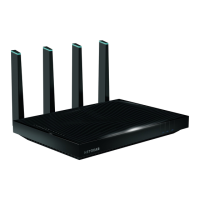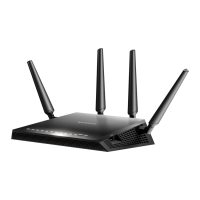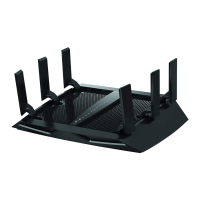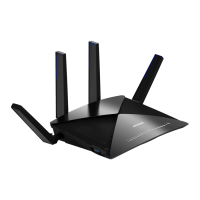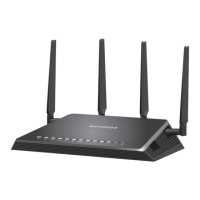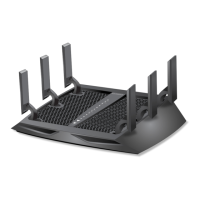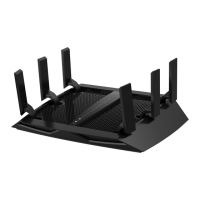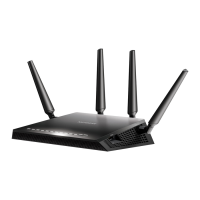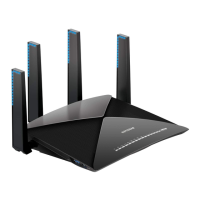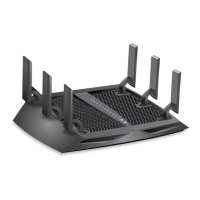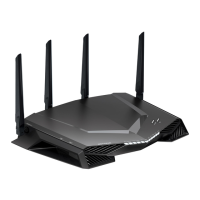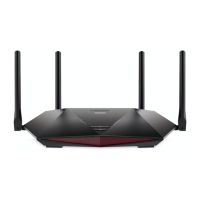Do you have a question about the NETGEAR Nighthawk X8 5 and is the answer not in the manual?
| Brand | NETGEAR |
|---|---|
| Model | Nighthawk X8 5 |
| Category | Wireless Router |
| Language | English |
Details the contents of the Nighthawk X8 AC5300 Tri-Band WiFi Router package.
Describes the location of LEDs, buttons, and USB ports on the front of the router.
Details the location and function of the router's USB ports.
Illustrates and describes the connections and buttons on the rear panel of the router.
Provides guidelines for optimal router placement to maximize WiFi signal range and performance.
Step-by-step instructions for connecting the router to your modem and power.
Explains the technology behind active antennas and their impact on WiFi signal strength.
Recommends antenna positions for single-story and multi-level homes for optimal WiFi coverage.
Explains how to connect your computer to the router via wired Ethernet or WiFi.
Differentiates between ISP login, WiFi password, and router login for clarity.
Guides users on accessing the router's web interface for setup and configuration.
Instructions on how to change the language of the router's user interface.
Explains how to use the NETGEAR genie app for managing, monitoring, and repairing your network.
Guides users through automatically detecting and setting up internet connection settings.
Provides steps to manually configure internet connection settings without the wizard.
Details how to configure various IPv6 connection types like Auto Detect, Auto Config, and Tunnel.
Explains how to adjust the Maximum Transmission Unit (MTU) size for network optimization.
Guides users to set up Live Parental Controls for managing internet access and filtering.
Describes how to use access control to allow or block specific devices from the network.
Explains how to block specific websites or domain names using keywords.
Details how to manage lists of allowed or blocked devices for network access control.
Allows users to set specific times and days for blocking internet sites and services.
Guides users on configuring email notifications for router activity and security events.
Explains the benefits of tri-band WiFi, including increased speed and reduced congestion.
Describes how Smart Connect balances 5 GHz WiFi connections for optimal device performance.
Explains how beamforming technology improves WiFi range and performance by directing signals.
Allows configuration of Wide Area Network (WAN) settings, including DMZ and MTU.
Configures a default DMZ server to improve compatibility with certain online applications.
Explains how to combine Gigabit Ethernet ports to enhance file transfer speed.
Guides users on modifying the router's LAN IP address and subnet mask.
Details how to configure the range of IP addresses assigned by the router's DHCP server.
Assists in connecting devices to the WiFi network using Wi-Fi Protected Setup (WPS).
Covers setting up essential WiFi parameters like SSID, security, and region.
Instructions for creating a separate WiFi network for guests, providing internet access only.
Explains how to configure the router to function as a WiFi bridge for extended network coverage.
Details how Dynamic QoS prioritizes traffic for improved internet performance.
Explains how UPnP helps devices discover and connect to network resources.
Describes WMM QoS for prioritizing voice and video traffic over WiFi.
Guides users on checking for and installing new router firmware for optimal performance.
Instructions for changing the router's administrative login password for security.
Provides an overview of the router's status, including connection and wireless information.
Explains how to back up, restore, or erase router configuration settings.
Details how to configure the router for remote access and management over the internet.
Steps for physically connecting a USB storage device to the router's USB port.
Guides users on mapping a USB device as a network drive in Windows for easy access.
Explains how to use ReadySHARE Vault for automatic backup of Windows computers.
Provides instructions on how to safely disconnect a USB device from the router.
Details on setting up a personal FTP server using Dynamic DNS for remote access.
Explains how to access USB devices remotely via the internet, with or without Dynamic DNS.
Guides on configuring the router as a DLNA media server for compatible devices.
Instructions for setting up the router's iTunes server to stream music via USB.
Explains how to configure the router to allow TiVo devices to play media from USB storage.
Steps for installing printer drivers and connecting a USB printer to the router.
Guides on using the NETGEAR USB Control Center utility to print documents.
Details on modifying settings for the NETGEAR USB Control Center, like startup and language.
Explains how to set up a virtual private network (VPN) for secure remote access.
Provides instructions for installing the OpenVPN client software on a computer.
Guides on using a VPN tunnel to access your home internet service remotely.
Details on configuring port forwarding to make local servers accessible from the internet.
Explains how port triggering dynamically opens ports for specific applications.
Provides general tips for resolving common router and network problems.
Explains how to interpret router LED status indicators for diagnosing issues.
Troubleshooting steps for when the router is accessible but internet connectivity fails.
Guides on using the ping utility to test network connectivity and troubleshoot issues.
Details the default factory settings of the router and how to perform a reset.
Provides detailed technical specifications for the Nighthawk X8 AC5300 Tri-Band WiFi Router.
